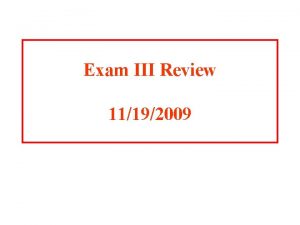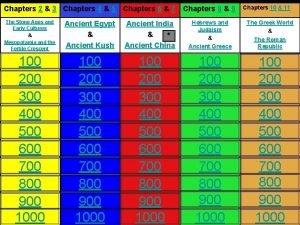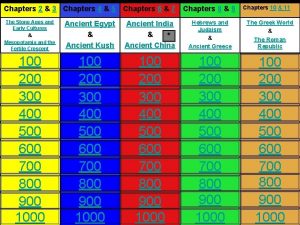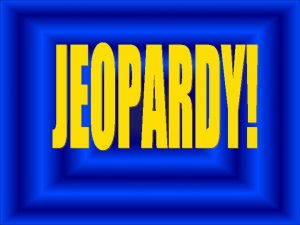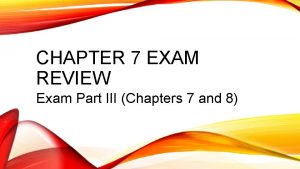Exam 1 Review Chapters 1 7 Exam Date








- Slides: 8

Exam 1 Review Chapters 1 -7 Exam Date: Wednesday, February 22 , 2012

Chapter 1 & 2 • Chapter 1 – Geology – Earth’s Major Layers • • • Crust Mantle Outer Core-Liquid Inner Core Differentiated – Uniformitarianism – Major Earth Features • Figure 1. 5 • Figure 1. 6 – Age of Earth: 4. 5 Billion Years • Chapter 2 – Major Earth Systems • Geologic System – Open – Closed • Hydrologic System – River or Fluvial Systems – Glacier – Groundwater • Eolian System • Tectonic System – – Hot Spots-mantle plumes Subduction zones Transform Boundaries Spreading Centers – Gravity and Isostasy – Observations –mostly water planet

Chapter 3 • Chapter 3 – Mineral – Matter – Mineral Formation – Chemical Classes • • • Silicates Sulfates Halides Carbonates Oxides Sulfides – Chemical Bonds • • Ionic Covalent – Mineral properties • • • Luster Hardness Streak Structure – Habit Cleavage – Three major rock types • • • Igneous Sedimentary Metamorphic – Mineral • Softest and Hardest Mineral • Limestone is made of Calcite • Best Cleavage – Mica » Muscovite » Biotite

Chapter 4 – Igneous Rock Classification • Texture – Aphanitic- fast cooling – Porphyritic – slow cooling • composition – Utramafic-Peridotite – Volcanic Extrusive • Rhyolite • Andesite • Basalt – Plutonic Intrusive • • • Granite Diorite Gabbro – Melting Rock – Origins of magma • melting • source • where formed – Magmatic differentiation – – – Forms of intrusions Fractional Crystallization Composition of early vs. late formed crystals – Continental Vs. oceanic – Major Zones of igneous Activity • spreading Centers – Mafic » Basalts » gabbros • subduction zones – Intermediate » Andesite » diorite – partial melt subducting ocean plate • Intraplate mantle plumes (hotspots)

Chapter 5 • • Sedimentary rocks and the rock cycle Classification • Sedimentary environments • • – Siliciclastic (Clastic-Detrital) – Chemical and biochemical – Continental – Shoreline-Coast – Marine Clastic vs. Chemical biochemical Structures – Stratification-bedding – mud cracks, ripples, cross bedding, graded bedding – bioturbation – Sequences – Sedimentary rocks product of • • • Parent rock Climate Agent and distance of transportation • Environment of deposition • • Burial and diagenesis – – heat, pressure, chemical alteration Compaction Cementation Lithification Types of sedimentary rocks – Conglomerate – Sandstones • arenites • Arkoses – – – Siltstone Claystone / shale Limestone Dolostone/dolomite Evaporites • Salt • gypsum – Coal • Sedimentary - Bituminous • Metamorphic - Anthracite

Chapter 6 • • • Causes of metamorphism – – Heat Confining pressure due to burial Directed pressure due to tectonics Fluids, chemical alteration Types of metamorphism – – – Regional Contact Seafloor (metasomatism) Burial High & ultra high pressure Shock Textures and types – Foliated • Slate, phyllite, schist, gneiss & migmatite – Unfoliated (granoblastic) – Hornfels marbles, greenstone ampibolite, porphyrpblast: garnet and staurolite • Metamorphic Grade Regional Metamorphism – – – Low grade High grade Temperature and Pressure Parent rock Composition Metamorphic facies • Plate tectonic and metamorphism • Metamorphic P-T paths – Spreading centers – metabasalts – Subduction zones- mélange and blue schists – Continent Ocean Convergence – Continent to continent Collisions • Ophiolites exhumation

Chapter 7 Structural Geology • Terms: – – – – • Normal fault. Strike-slip fault. Thrust fault Reverse fault Joints Fractures Anticline Syncline Dome Basin Limbs Folds Overturned anticline Recumbent fold Plunging Anticline or Syncline Concepts – Older rocks in middle of eroded anticline or dome – Younger rocks in middle of eroded syncline or basin – Eroded Plunging Anticline has a zigzag outcrop pattern – Dip and strike measurements – Fold Axis – Effects of joints relative to faults – What tectonic forces control faulting: • Folding and thrust faultscompression • Grabens and horst blocks-tension • Offset rivers streams-shear – Rock Behavior • Ductile • Brittle • Plastic – Intrinsic Stress See next slide

Plunging anticlines and synclines









